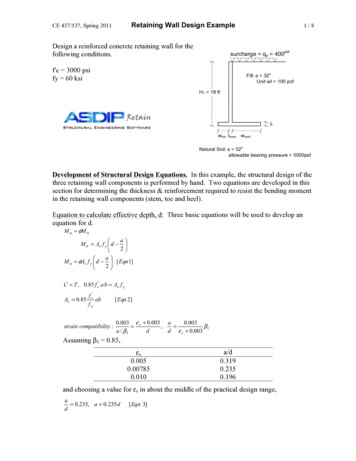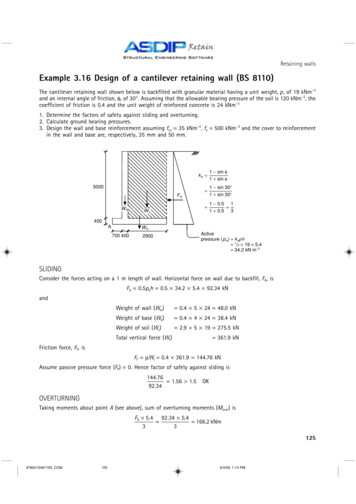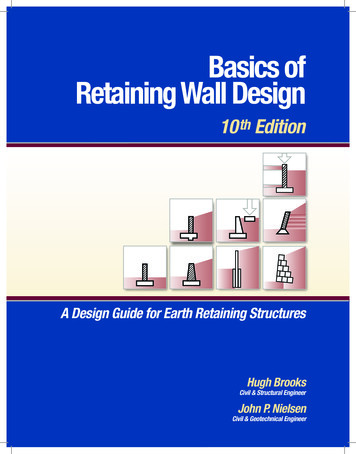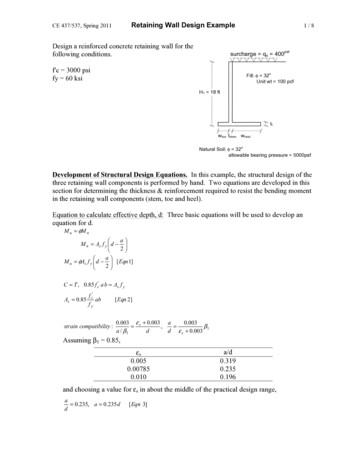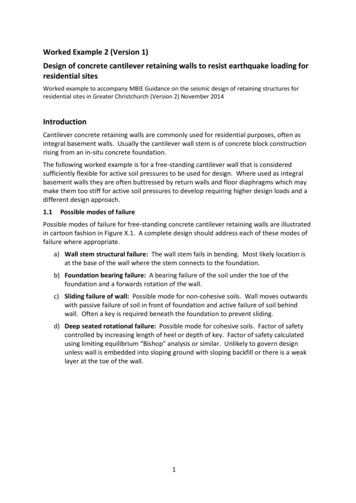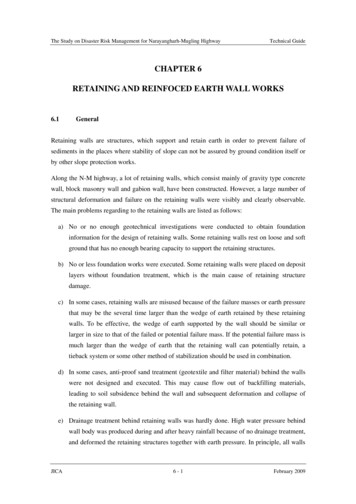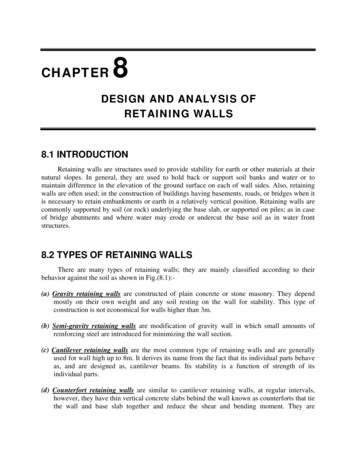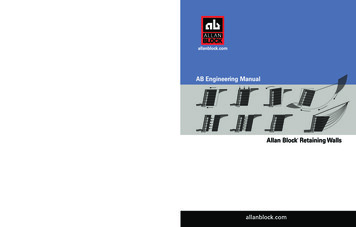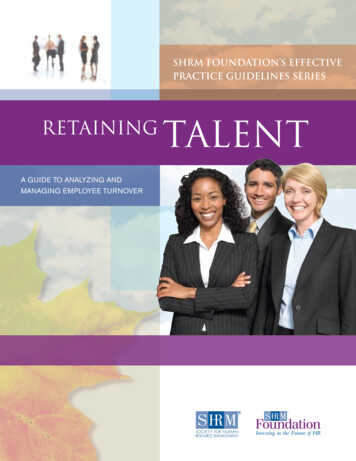
Transcription
SHRM Foundation’s EffectivePractice Guidelines SeriesRetainingA Guide to Analyzing andManaging Employee TurnoverTalent
SHRM Foundation’s Effective Practice Guidelines SeriesRETAININGTalentA Guide to Analyzingand Managing EmployeeTurnoverby David G. Allen, Ph.D., SPHRi
RETAININGTalentThis publication is designed to provide accurate and authoritative information regarding the subject matter covered. Neither the publisher nor the author is engaged in rendering legal or other professional service. If legal advice or other expert assistance is required,the services of a competent, licensed professional should be sought. Any federal and state laws discussed in this book are subject tofrequent revision and interpretation by amendments or judicial revisions that may significantly affect employer or employee rights andobligations. Readers are encouraged to seek legal counsel regarding specific policies and practices in their organizations.This book is published by the SHRM Foundation, an affiliate of the Society for Human Resource Management (SHRM ). Theinterpretations, conclusions and recommendations in this book are those of the author and do not necessarily represent those of theSHRM Foundation. 2008 SHRM Foundation. All rights reserved. Printed in the United States of America.This publication may not be reproduced, stored in a retrieval system or transmitted in whole or in part, in any form or by any means,electronic, mechanical, photocopying, recording or otherwise, without the prior written permission of the SHRM Foundation, 1800Duke Street, Alexandria, VA 22314.The SHRM Foundation is the 501(c)3 nonprofit affiliate of the Society for Human Resource Management (SHRM). The SHRMFoundation maximizes the impact of the HR profession on organizational decision-making and performance by promoting innovation, education, research and the use of research-based knowledge. The Foundation is governed by a volunteer board of directors,comprising distinguished HR academic and practice leaders. Contributions to the SHRM Foundation are tax deductible. Visit theFoundation online at www.shrm.org/foundation.For more information, contact the SHRM Foundation at (703) 535-6020.ii
Table ofContentsvForewordviiAcknowledgmentsixAbout the Author1Retaining Talent2What Is Turnover, Exactly?3Why Turnover Matters5Why Employees Leave9Why Employees Stay10How to Develop Your RetentionManagement Plan21A Menu of Retention Practices27Conclusion28References33Sources and Suggested Readingsiii
ForewordDear Colleague:As a busy human resource professional, you probably find it difficultto keep up with the latest academic research in the field. Yet knowingwhich HR practices have been shown by research to be effective canhelp you in your role as an HR professional.That’s why the SHRM Foundation created the Effective PracticeGuidelines series. These reports distill the latest research findings andexpert opinion into specific advice on how to conduct effective HRpractice. Written in a concise, easy-to-read style, these publicationsprovide practical information to help you do your job better.The Effective Practice Guidelines were created in 2004. The SHRMFoundation publishes new reports annually on different HR topics.Past reports, available online at www.shrm.org/foundation, includePerformance Management, Selection Assessment Methods, EmployeeEngagement and Commitment, Implementing Total Rewards Strategiesand Developing Leadership Talent. You are now reading the sixth reportin the series: Retaining Talent.For each report, a subject matter expert is chosen to be the author.The report is reviewed by a panel of academics and practitioners toensure that the material is comprehensive and meets the needs of HRpractitioners. An annotated bibliography, “Sources and SuggestedReadings” section, is included with each report as a convenientreference tool.This process ensures that the advice you receive in these reports is usefuland based on solid academic research.Our goal with this series is to present relevant, research-basedknowledge in an easy-to-use format. Our vision for the SHRMFoundation is to “maximize the impact of the HR profession onorganizational decision-making and performance, by promotinginnovation, education, research and the use of research-basedknowledge.” In particular, we are strategically focused on initiativesdesigned to help organizations maximize leadership talent. This includesa focus on the assessment and acquisition of leadership talent, as well asleadership development, retention, and succession.We are confident that the Effective Practice Guidelines series takes us onestep closer to making that vision a reality.Frederick P. Morgeson, Ph.D.Chair, SHRM Foundation Research Applications CommitteeProfessor of Management, Michigan State Universityv
AcknowledgementsThe author gratefully acknowledges the assistance of Phil C. Bryant and JamesM. Vardaman in the preparation of this report, as well as the helpful commentsof Dr. Charles A. Pierce.The SHRM Foundation is grateful for the assistance of the followingindividuals in producing this report:Content EditorsReviewersHerbert G. Heneman III, Ph.D.Dickson-Bascom Professor inBusinessUniversity of Wisconsin-MadisonMeredith Brooks Carpenter, PHRFrederick P. Morgeson, Ph.D.Professor of ManagementEli Broad College of BusinessMichigan State UniversityBooz Allen Hamilton Inc.Martha R.A. FieldsPresident and CEOFields Associates, Inc.John D. Kammeyer-Mueller,Ph.D.Beth M. McFarland, CAEAssistant ProfessorWarrington College of BusinessAdministrationUniversity of FloridaManager, Special ProjectsSHRM FoundationMerry Lee Lison, SPHRProject ManagerDirector, Human ResourcesTRC Global Solutions, Inc.Major funding for the Effective Practice Guidelines series is provided by theHuman Resource Certification Institute and the Society for HumanResource Management.vii
Retaining TalentAbout the AuthorDavid G. AllenDavid Allen earned his Ph.D. from the Beebe Institute of Personneland Employment Relations at Georgia State University. He is currentlyan Associate Professor of Management in the Fogelman Collegeof Business and Economics at the University of Memphis, and theDirector of the Management Ph.D. program. His primary researchinterests include the flow of people into and out of organizations andthe role of technology in human resource management. His researchon these topics has been published in the Academy of ManagementJournal, Journal of Applied Psychology, Journal of Management, PersonnelPsychology, Organizational Research Methods, Human Relations, andother outlets.Dr. Allen is a 2005-2006 recipient of a Suzanne Downs PalmerProfessorship award for research. He teaches undergraduate andgraduate courses primarily in the areas of human resource managementand organizational behavior, as well as research methods. He doesorganizational research and consulting on topics such as recruitment,retention, and organizational effectiveness. He earned the designationof Senior Professional in Human Resources (SPHR) from theHuman Resource Certification Institute. Dr. Allen has worked withorganizations such as the Red Cross, Campbell Clinic, GeorgiaDepartment of Family and Children Services, Harrah’s Entertainment,Methodist Hospitals, Pfizer, Region’s Bank, and the U.S. Navy.ix
In 2006, 23.7% of American workers voluntarily quit their jobs.-- U.S. Bureau of Labor Statistics
Retaining TalentRetaining Talent: A Guide to Analyzing andManaging Employee Turnoverby David G. Allen, Ph.D., SPHROne of the most critical issues facing organizations today is how to retain theemployees they want to keep. Yet nearly one quarter of all U.S. workers quittheir jobs in 2006, and in some industries the turnover rate is considerablyhigher. There are more than 1,000 published research articles on turnoverand retention. As a busy human resource practitioner, do you have the timeto read them all, synthesize their recommendations, and translate them intousable practices to improve retention? If you’re like most HR professionals, youprobably do not. That’s why the SHRM Foundation prepared this report—tosummarize the latest research findings on employee turnover and retention andoffer ideas for putting those findings into action in your organization.This report explores several major themes related to retention management:Why employees leave and why they stay. This presents the major theoriesand research findings in this area and explores the practical implications ofeach. A model is provided depicting how employees make turnover decisions.How to develop an effective retention management plan. To create asound plan, you need to determine the extent to which turnover is a problemin your firm, diagnose turnover drivers, and formulate retention strategies.These sections explain how to take these steps and include summaries ofresearch on strategies.Let’s start by exploring what turnover is and why it is important to manage it.Reducing Turnover at American Home ShieldAmerican Home Shield, the major appliance warranty arm of ServiceMaster, isbased in Memphis, Tenn. and has about 1,500 employees. A critical departmentat American Home Shield was experiencing an annual turnover rate of 89%.The company estimated the direct financial costs associated with losingemployees and hiring and training replacements at over 250,000 annually.Managers also believed that the high turnover rate was eroding employeemorale and customer loyalty. Using research-based retention management, thedepartment reduced turnover to 35% in about one year.Source: Phil Bryant, former HR Manager, American Home Shield1
Retaining TalentTo manage voluntaryturnover in yourorganization, you needan in-depth understandingof why employees leaveor stay with organizationsWhat Is Turnover, Exactly?Employees leave organizations for all sorts of reasons. Some find a different job,some go back to school, and some follow a spouse who has been transferredout of town. Others retire, get angry about something and quit on impulse,or never intended to keep working after earning a certain amount of money.Still others get fired or laid off, or they come into money (a lottery win, aninheritance) and decide they no longer need a job.All of these examples represent turnover, but they don’t all have the sameorganizational implications. To distinguish their implications, we need to definetypes of turnover. Consider Figure 1 Turnover Classification Scheme.1in general, as well asstrategies for managingFigure 1: Turnover Classification Schemeturnover among valuedTurnoverworkers in your lUnavoidableAvoidableAs Figure 1 suggests, the first important distinction in turnover is betweenvoluntary and involuntary. Voluntary turnover is initiated by the employee; forexample, a worker quits to take another job. Involuntary turnover is initiatedby the organization; for instance, a company dismisses an employee due to poorperformance or an organizational restructuring. Voluntary and involuntaryturnover require markedly different management techniques. This report focuseson voluntary turnover. To manage voluntary turnover in your organization,you need an in-depth understanding of why employees leave or stay withorganizations in general, as well as strategies for managing turnover amongvalued workers in your company.Another important distinction is between functional and dysfunctionalvoluntary turnover. Dysfunctional turnover is harmful to the organization andcan take numerous forms, including the exit of high performers and employeeswith hard-to-replace skills, departures of women or minority group membersthat erode the diversity of your company’s workforce, and turnover rates that2
Retaining Talentlead to high replacement costs. Bycontrast, functional turnover doesnot hurt an organization. Examplesof this type of turnover include theexit of poor performers or employeeswhose talents are easy to replace.This distinction between functionaland dysfunctional turnover isrelative. What makes an employeevaluable and difficult to replacewill vary by job, organization,industry, and other factors. Toillustrate, a high turnover rate maybe more dysfunctional in an industrycharacterized by skills that are inrare supply. Moreover, the questionof whether the benefits of retaininga valued worker are worth the costsmay generate a different answerin some companies than in others,depending on the organization’sstrategy and the current labormarket.Could your organization retain allits valued employees if it wantedto? The answer is no. Even if youinvested heavily in keeping everykey employee on board, some ofthose individuals would still leave.This brings up another importantdistinction: Some voluntary turnoveris avoidable and some is unavoidable.Avoidable turnover stems fromcauses that the organization may beable to influence. For example, ifemployees are leaving because of lowjob satisfaction, the company couldimprove the situation by redesigningjobs to offer more challenge or moreopportunities for people to developtheir skills. Unavoidable turnoverstems from causes over which theorganization has little or no control.For instance, if employees leavebecause of health problems or adesire to return to school, there maybe little the organization can do tokeep them.Organizations that systematicallymanage retention—in good timesand bad—will stand a greater chanceof weathering such shortages.The distinction between avoidableand unavoidable turnover isimportant because it makes littlesense for a firm to invest heavilyin reducing turnover that arisesfrom largely unavoidable reasons.However, the line between avoidableand unavoidable turnover can befuzzy. To illustrate, your companyhas no control over whether anemployee decides to start a family.Yet it can elect to offer paidmaternity leave, on-site child care,and other benefits intended to helpworking parents stay with yourorganization.Turnover
i by David G. Allen, Ph.D., SPHR A GuiDe to AnAlyzinG AnD MAnAGinG eMPloyee tuRnoveR SHRM Foundation’S EFFEctivE PRacticE GuidElinES SERiES REtaininG

